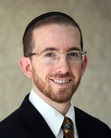Natan Slifkin's Blog, page 166
September 15, 2013
A Breathtaking Endeavor
I've been blessed to have some breathtaking experiences in my life. I've seen the sun set on Mount Kilimanjaro in Kenya and I've experienced the thunder of Victoria Falls in Zambia. I've watched whales in the Pacific, great white sharks hunting seals off Cape Point, and I've been horse-riding in the Alps. And, of course, I've had close encounters with lions, cheetahs, bears, elephants, hippos, beluga whales, and a host of other remarkable animals. But this past summer, I had an experience which, to my surprise, was as breathtaking as any of these.
 Los Angeles was full of flyers advertising a new exhibit on display at the California Science Center: the NASA OV-105 (Orbital Vehicle 105), better known as the Space Shuttle Endeavor. I duly took my family to see it. What I wasn't expecting was that upon seeing it, I would literally (and I mean "literally" literally) gasp, and feel a powerful emotion of awe. (If you're reading this in a web browser, you can click on the hi-res image on the right to embiggen it and get a better sense of its awesomeness.)
Los Angeles was full of flyers advertising a new exhibit on display at the California Science Center: the NASA OV-105 (Orbital Vehicle 105), better known as the Space Shuttle Endeavor. I duly took my family to see it. What I wasn't expecting was that upon seeing it, I would literally (and I mean "literally" literally) gasp, and feel a powerful emotion of awe. (If you're reading this in a web browser, you can click on the hi-res image on the right to embiggen it and get a better sense of its awesomeness.)
Now, it's true that the space shuttle was always a big deal for me. As a kid (and, truth be told, even as an adult) I was always a huge fan of spaceships. Star Wars, Battlestar Galactica, Battle of the Planets, Lego Space models, you name it. I remember that as a third-grader, I did a school project which I called "Into The Future," about space exploration; in an ironic precursor of future events, a zealous classmate slammed it as kefirah!
Still, I wasn't the only one to feel such powerful emotions upon seeing the OV-105. My wife, who was was certainly no spaceship enthusiast in her youth, was tending to the baby when I entered the exhibit, and thus entered later and separately. She told me that when she saw the shuttle, she was overcome with emotion, with tears welling up in her eyes.
 Why was it such an awesome sight? The shuttle is not as big as an airliner. But it does look very different. For example, instead of a smooth exterior, it is covered in textured insulating tiles - each about eight inches square, individually numbered, separately sized, costing about $2000 apiece, and fragile enough to be crushed by hand! The shuttle also has all kinds of ports and hatches and devices all over it, setting it aside as a Very Unique Vehicle. And those engines!
Why was it such an awesome sight? The shuttle is not as big as an airliner. But it does look very different. For example, instead of a smooth exterior, it is covered in textured insulating tiles - each about eight inches square, individually numbered, separately sized, costing about $2000 apiece, and fragile enough to be crushed by hand! The shuttle also has all kinds of ports and hatches and devices all over it, setting it aside as a Very Unique Vehicle. And those engines!
But it certainly wasn't just the appearance of the shuttle that made the experience so breathtaking. Rather, it was what the shuttle represented. As a child/ teenager in the 80s, the space shuttle truly epitomized the wonder of technological progress. It looked like soon there would be lunar bases and interplanetary exploration, with the USS Enterprise not far off in the future. Of course, the space program didn't quite work out that way, and it seems to have taken a step backwards with the decommissioning of the space shuttle; nowadays, the most exciting part of the space program is when a frog tries to hitch a ride. But for people my age, the space shuttle was mankind's most glorious technological achievement.
 For me, seeing the OV-105 was a religious moment. Floundering for the correct response, I pronounced the blessing of Baruch shenasan me-chachmaso l'bnei adam, "Blessed is He who has given of His wisdom to mankind." This is a blessing recited upon seeing a great scholar of secular wisdom; I figured that the shuttle represents the fruits of such wisdom.
For me, seeing the OV-105 was a religious moment. Floundering for the correct response, I pronounced the blessing of Baruch shenasan me-chachmaso l'bnei adam, "Blessed is He who has given of His wisdom to mankind." This is a blessing recited upon seeing a great scholar of secular wisdom; I figured that the shuttle represents the fruits of such wisdom.
My wife told me that when she saw it, she spontaneously wanted to recite the blessing of Baruch Oseh Maase Bereishis, "Blessed is the One who makes the work of creation." Then she felt that it would not be correct, because that is a blessing to be pronounced upon the work of God, whereas the shuttle is the work of man.
I'm not sure that it wouldn't be appropriate. The space shuttle is the pinnacle of man's technological prowess, which in turn is the result of his three-pound brain. Which in turn is the single most complex entity in the known universe - the single greatest and most remarkable element of creation. In The Challenge Of Creation , I quoted the following from mathematician Morris Kline:

 Los Angeles was full of flyers advertising a new exhibit on display at the California Science Center: the NASA OV-105 (Orbital Vehicle 105), better known as the Space Shuttle Endeavor. I duly took my family to see it. What I wasn't expecting was that upon seeing it, I would literally (and I mean "literally" literally) gasp, and feel a powerful emotion of awe. (If you're reading this in a web browser, you can click on the hi-res image on the right to embiggen it and get a better sense of its awesomeness.)
Los Angeles was full of flyers advertising a new exhibit on display at the California Science Center: the NASA OV-105 (Orbital Vehicle 105), better known as the Space Shuttle Endeavor. I duly took my family to see it. What I wasn't expecting was that upon seeing it, I would literally (and I mean "literally" literally) gasp, and feel a powerful emotion of awe. (If you're reading this in a web browser, you can click on the hi-res image on the right to embiggen it and get a better sense of its awesomeness.) Now, it's true that the space shuttle was always a big deal for me. As a kid (and, truth be told, even as an adult) I was always a huge fan of spaceships. Star Wars, Battlestar Galactica, Battle of the Planets, Lego Space models, you name it. I remember that as a third-grader, I did a school project which I called "Into The Future," about space exploration; in an ironic precursor of future events, a zealous classmate slammed it as kefirah!
Still, I wasn't the only one to feel such powerful emotions upon seeing the OV-105. My wife, who was was certainly no spaceship enthusiast in her youth, was tending to the baby when I entered the exhibit, and thus entered later and separately. She told me that when she saw the shuttle, she was overcome with emotion, with tears welling up in her eyes.
 Why was it such an awesome sight? The shuttle is not as big as an airliner. But it does look very different. For example, instead of a smooth exterior, it is covered in textured insulating tiles - each about eight inches square, individually numbered, separately sized, costing about $2000 apiece, and fragile enough to be crushed by hand! The shuttle also has all kinds of ports and hatches and devices all over it, setting it aside as a Very Unique Vehicle. And those engines!
Why was it such an awesome sight? The shuttle is not as big as an airliner. But it does look very different. For example, instead of a smooth exterior, it is covered in textured insulating tiles - each about eight inches square, individually numbered, separately sized, costing about $2000 apiece, and fragile enough to be crushed by hand! The shuttle also has all kinds of ports and hatches and devices all over it, setting it aside as a Very Unique Vehicle. And those engines!But it certainly wasn't just the appearance of the shuttle that made the experience so breathtaking. Rather, it was what the shuttle represented. As a child/ teenager in the 80s, the space shuttle truly epitomized the wonder of technological progress. It looked like soon there would be lunar bases and interplanetary exploration, with the USS Enterprise not far off in the future. Of course, the space program didn't quite work out that way, and it seems to have taken a step backwards with the decommissioning of the space shuttle; nowadays, the most exciting part of the space program is when a frog tries to hitch a ride. But for people my age, the space shuttle was mankind's most glorious technological achievement.
 For me, seeing the OV-105 was a religious moment. Floundering for the correct response, I pronounced the blessing of Baruch shenasan me-chachmaso l'bnei adam, "Blessed is He who has given of His wisdom to mankind." This is a blessing recited upon seeing a great scholar of secular wisdom; I figured that the shuttle represents the fruits of such wisdom.
For me, seeing the OV-105 was a religious moment. Floundering for the correct response, I pronounced the blessing of Baruch shenasan me-chachmaso l'bnei adam, "Blessed is He who has given of His wisdom to mankind." This is a blessing recited upon seeing a great scholar of secular wisdom; I figured that the shuttle represents the fruits of such wisdom. My wife told me that when she saw it, she spontaneously wanted to recite the blessing of Baruch Oseh Maase Bereishis, "Blessed is the One who makes the work of creation." Then she felt that it would not be correct, because that is a blessing to be pronounced upon the work of God, whereas the shuttle is the work of man.
I'm not sure that it wouldn't be appropriate. The space shuttle is the pinnacle of man's technological prowess, which in turn is the result of his three-pound brain. Which in turn is the single most complex entity in the known universe - the single greatest and most remarkable element of creation. In The Challenge Of Creation , I quoted the following from mathematician Morris Kline:
A study of mathematics and its contributions to the sciences exposes a deep question. Mathematics is man-made. The concepts, the broad ideas, the logical standards and methods of reasoning... were fashioned by human beings. Yet with the product of his fallible mind, man has surveyed spaces too vast for his imagination to encompass; he has predicted and shown how to control radio waves which none of our senses can perceive; and he has discovered particles too small to be seen with the most powerful microscope... Some explanation of this marvelous power is called for.Who would predict a universe in which the laws of nature are able to produce a being that can figure out a way to leave its home planet? Baruch Oseh Maase Bereishis!

Published on September 15, 2013 06:59
September 11, 2013
Revolutions in Jewish Intellectual History
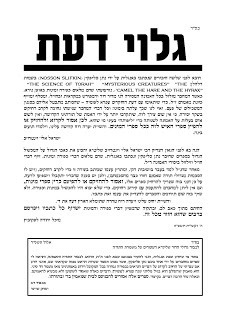
Yesterday was the ninth anniversary of the day that I received a phone call from Bnei Brak, telling me that I had until the end of the day to retract my books and publicly apologize, or face scandal and humiliation. (If you were living on a different planet in 2004/5, you can read all about the ban at this link.) I picked the second option. It was very painful, though less so in the long run than the first option would have been.
One of the most significant and passionate of my opponents was Rav Moshe Shapiro. He presented himself as following in the path of Maharal. But a certain rav, to whom I am close, and who is an aficionado of Maharal, felt that Rav Shapiro was not portraying Maharal's position correctly.
After several years of study and contemplation, I had to disagree. I felt that Rav Shapiro was perfectly following Maharal's approach. But this did not make his opposition to my work justified. Maharal himself was a revolutionary, who went entirely against the approach of all the Rishonim (and of Chazal). It was truly ironic that such a revolutionary figure was being used to condemn the "heresy" of an approach that has a much more authentic lineage!
Rabbi Chaim Eisen began the process of documenting Maharal's revolutionary approach in a seminal article in the journal Hakirah (freely available here). But I feel that Rabbi Eisen's article did not cover some crucial aspects of the way in which Maharal's approach was innovative. I have documented these in a paper entitled "Maharal's Multiple Revolutions in Aggadic Scholarship," which you can download at this link. If you feel that you benefit from it, and/or from this blog in general, please make a donation to the Torah and Nature Foundation, which is the fund for my projects relating to natural history - currently, the Zoo Torah documentary, The Torah Encyclopedia of the Animal Kingdom, and The Jewish Museum of Natural History. You can donate with either a credit card or PayPal account by clicking on the button below. Thank you for your support!

Published on September 11, 2013 10:50
September 10, 2013
K'neged Kulam!
Any discussion about the over-emphasis given to studying Torah has to begin with the following statement of Chazal: "Talmud Torah k'neged kulam," usually translated as "Studying Torah is equal to all other mitzvos." This is commonly cited as a trump card for shutting down any discussion relating to people's obligations:
Here, then, is a list of reasons as to why Talmud Torah k'neged kulam does not mean what it is commonly thought to mean.
1. Who says that Talmud Torah means studying Torah? And what does "studying Torah" mean?
As R. Dr. Yehudah Levi notes in his classic book "Torah Study," the phrase Talmud Torah, properly translated, seems to refer to teaching Torah rather than learning Torah. This is also implied by the Gemara, which derives the mitzvah of Talmud Torah from the passuk of veshinantam levanecha, "you shall teach it to your sons."
Certainly, later authorities took it to mean studying Torah. But it is not clear that Chazal meant it that way, at least not in every instance. And it certainly seems to be the case that even learning Torah was, as far as Chazal and the Rishonim were concerned, primarily about knowing how to observe halachah and how to teach others to observe halachah.
2. Other mitzvos are also described as being k'neged kulam!
There are several mitzvos about which Chazal say that they are equal to all other mitzvos together. These are the mitzvah of living in Eretz Yisrael, Shabbos, Bris Milah, Tzitzis, and Gemilas Chasadim. (See this link for sources and discussion.) Can you imagine if someone were to propose one of these sources in a similar context in which people say Talmud Torah k'neged kulam?
3. K'neged kulam does not mean that it exempts a person from other obligations!
Chazal, the very authorities who said Talmud Torah k'neged kulam, also said that a person is obligated to teach their son a trade, and to take a lowly profession rather than beg for charity. And they did not issue a blanket exemption from military service for people who study Torah.
4. It's clearly an exaggeration.
In practice, nobody, not even Chazal, take Talmud Torah k'neged kulam to mean that any given moment of Torah study is equal in value to all other mitzvos combined. If they did, then there would never be grounds to do an optional mitzvah, much less to institute any kind of non-critical act, religious or otherwise, that could take people away from a moment of Torah study. And so it's clearly an exaggeration.
So, having said all that, what does Talmud Torah k'neged kulam actually mean? Even assuming that it refers to Torah study rather than Torah teaching, it would mean something along the lines of the Gemara in Kiddushin 40b, where the question is asked, which is greater, study or action? One view, of Rabbi Tarfon the non-heretic, is that action is greater, but the consensus is that study is greater - and the reason given is that study leads to action! This is as per the Rishonim, who describe the purpose of Torah study as knowing how to observe the mitzvos. You can't know how to live life properly unless you learn how.
When Chazal said that learning/ teaching Torah is equal to all other mitzvos, they meant that learning and/or teaching how to keep the mitzvos is of fundamental importance. And that's all.
"Why don't you work to support your family?"And, predictably, someone cited it in the comments to the previous post, presumably in order to claim that it's impossible to over-emphasize the mitzvah of Talmud Torah, since Talmud Torah k'neged kulam.
"Talmud Torah k'neged kulam!"
"Why don't you teach your children a trade, as Chazal instruct?"
"Talmud Torah k'neged kulam!"
"Why don't charedim share the burden of military service and supporting the economy?"
"Talmud Torah k'neged kulam!"
Here, then, is a list of reasons as to why Talmud Torah k'neged kulam does not mean what it is commonly thought to mean.
1. Who says that Talmud Torah means studying Torah? And what does "studying Torah" mean?
As R. Dr. Yehudah Levi notes in his classic book "Torah Study," the phrase Talmud Torah, properly translated, seems to refer to teaching Torah rather than learning Torah. This is also implied by the Gemara, which derives the mitzvah of Talmud Torah from the passuk of veshinantam levanecha, "you shall teach it to your sons."
Certainly, later authorities took it to mean studying Torah. But it is not clear that Chazal meant it that way, at least not in every instance. And it certainly seems to be the case that even learning Torah was, as far as Chazal and the Rishonim were concerned, primarily about knowing how to observe halachah and how to teach others to observe halachah.
2. Other mitzvos are also described as being k'neged kulam!
There are several mitzvos about which Chazal say that they are equal to all other mitzvos together. These are the mitzvah of living in Eretz Yisrael, Shabbos, Bris Milah, Tzitzis, and Gemilas Chasadim. (See this link for sources and discussion.) Can you imagine if someone were to propose one of these sources in a similar context in which people say Talmud Torah k'neged kulam?
3. K'neged kulam does not mean that it exempts a person from other obligations!
Chazal, the very authorities who said Talmud Torah k'neged kulam, also said that a person is obligated to teach their son a trade, and to take a lowly profession rather than beg for charity. And they did not issue a blanket exemption from military service for people who study Torah.
4. It's clearly an exaggeration.
In practice, nobody, not even Chazal, take Talmud Torah k'neged kulam to mean that any given moment of Torah study is equal in value to all other mitzvos combined. If they did, then there would never be grounds to do an optional mitzvah, much less to institute any kind of non-critical act, religious or otherwise, that could take people away from a moment of Torah study. And so it's clearly an exaggeration.
So, having said all that, what does Talmud Torah k'neged kulam actually mean? Even assuming that it refers to Torah study rather than Torah teaching, it would mean something along the lines of the Gemara in Kiddushin 40b, where the question is asked, which is greater, study or action? One view, of Rabbi Tarfon the non-heretic, is that action is greater, but the consensus is that study is greater - and the reason given is that study leads to action! This is as per the Rishonim, who describe the purpose of Torah study as knowing how to observe the mitzvos. You can't know how to live life properly unless you learn how.
When Chazal said that learning/ teaching Torah is equal to all other mitzvos, they meant that learning and/or teaching how to keep the mitzvos is of fundamental importance. And that's all.
Published on September 10, 2013 11:34
September 8, 2013
Over-Emphasizing The Truly Important
Can the importance of something that is really important be over-emphasized?
Yes, of course it can. As long as something is not the only matter of importance, it is possible to over-emphasize its importance. The engine is by far the most important component of a car; but it is possible to over-emphasize the importance of the engine.
Still, when something is really important, and is not taken at all seriously enough by many people, and especially if it is something that defines one's social group, then some people will naturally be hostile to the proposal that it is being over-emphasized. And so I expect that this post, and the series of posts that it launches, will receive a great deal of opposition.
Twenty years ago, the head of a well-known school in Jerusalem told me why he decided to reject Religious Zionism and join the Charedi world. He said that while yishuv ha'aretz is important, it seemed a perversion of Judaism to take one mitzvah and define one's entire religious life around it.
Without commenting on that directly, it seems to me that the Charedi world, which often refers to itself (in exclusion to the Religious-Zionist and Modern/Centrist Orthodox) as the community of "Torah Jews," does the exact same thing with regard to a different mitzvah. I am talking, of course, about the mitzvah of Talmud Torah.
Beginning about two centuries ago, and accelerating in the last few decades, the mitzvah of Torah study has been dramatically transformed in both the importance attached to it, and in the very nature and function of the act itself. With regard to the latter aspect, I introduced this topic a few months ago, in a post entitled Learning Torah: Rationalism Vs. Mysticism, when I discussed the difference between the rationalist and non-rationalist/ mystical approaches to Judaism with regard to avodas Hashem, the service of God. Rationalists understand the purpose of mitzvos, and religious life in general, as furthering intellectual and moral goals for the individual and society. Mystics agree that mitzvos provide intellectual and moral benefits, but see their primary function as performing mechanistic manipulations of spiritual or celestial forces. Examples of this difference are the mitzvos of mezuzah , netilas yadayim , and shiluach hakein .
Another example is the mitzvah of learning Torah. For the rationalist Rishonim (as well as for Chazal), learning Torah serves to increase one's knowledge, and to refine one's character, via moral lessons and learning the commandments. (See my post on The Rishonim on Torah Study.) With the rise of mysticism, on the other hand, came a new and primary function of Torah study. As expressed by R. Chaim of Volozhin in Nefesh HaChaim, the primary function of Torah study was now seen as being to metaphysically sustain the universe, via the creation of spiritual "worlds." Another aspect of this transformation is that learning Torah became an end unto itself. (See my post on The Goal of Torah Study.)
A few months ago, I met a successful Torah educator who said to me, "The charedi world has made learning Torah into an avodah zarah." I wouldn't have phrased it that way myself. But the ramifications of the difference between the rationalist and mystical views of Torah study, which relate to the increase in importance that has recently been given to Torah study, are vast and often catastrophic. In future posts (not necessarily consecutive), I will be discussing examples of this phenomenon.
Yes, of course it can. As long as something is not the only matter of importance, it is possible to over-emphasize its importance. The engine is by far the most important component of a car; but it is possible to over-emphasize the importance of the engine.
Still, when something is really important, and is not taken at all seriously enough by many people, and especially if it is something that defines one's social group, then some people will naturally be hostile to the proposal that it is being over-emphasized. And so I expect that this post, and the series of posts that it launches, will receive a great deal of opposition.
Twenty years ago, the head of a well-known school in Jerusalem told me why he decided to reject Religious Zionism and join the Charedi world. He said that while yishuv ha'aretz is important, it seemed a perversion of Judaism to take one mitzvah and define one's entire religious life around it.
Without commenting on that directly, it seems to me that the Charedi world, which often refers to itself (in exclusion to the Religious-Zionist and Modern/Centrist Orthodox) as the community of "Torah Jews," does the exact same thing with regard to a different mitzvah. I am talking, of course, about the mitzvah of Talmud Torah.
Beginning about two centuries ago, and accelerating in the last few decades, the mitzvah of Torah study has been dramatically transformed in both the importance attached to it, and in the very nature and function of the act itself. With regard to the latter aspect, I introduced this topic a few months ago, in a post entitled Learning Torah: Rationalism Vs. Mysticism, when I discussed the difference between the rationalist and non-rationalist/ mystical approaches to Judaism with regard to avodas Hashem, the service of God. Rationalists understand the purpose of mitzvos, and religious life in general, as furthering intellectual and moral goals for the individual and society. Mystics agree that mitzvos provide intellectual and moral benefits, but see their primary function as performing mechanistic manipulations of spiritual or celestial forces. Examples of this difference are the mitzvos of mezuzah , netilas yadayim , and shiluach hakein .
Another example is the mitzvah of learning Torah. For the rationalist Rishonim (as well as for Chazal), learning Torah serves to increase one's knowledge, and to refine one's character, via moral lessons and learning the commandments. (See my post on The Rishonim on Torah Study.) With the rise of mysticism, on the other hand, came a new and primary function of Torah study. As expressed by R. Chaim of Volozhin in Nefesh HaChaim, the primary function of Torah study was now seen as being to metaphysically sustain the universe, via the creation of spiritual "worlds." Another aspect of this transformation is that learning Torah became an end unto itself. (See my post on The Goal of Torah Study.)
A few months ago, I met a successful Torah educator who said to me, "The charedi world has made learning Torah into an avodah zarah." I wouldn't have phrased it that way myself. But the ramifications of the difference between the rationalist and mystical views of Torah study, which relate to the increase in importance that has recently been given to Torah study, are vast and often catastrophic. In future posts (not necessarily consecutive), I will be discussing examples of this phenomenon.
Published on September 08, 2013 07:35
September 3, 2013
The Fabric of Life
This year ended on a tragic note for my family, but I would therefore like to conclude the year's blog postings with a post celebrating life. And so I am writing about a tablecloth.
In July, on my trip to Africa, I spent a few days in Johannesburg before meeting my group. On my first evening, I was invited to dinner at the beautiful home of Jake and Loren Shepherd, readers of my work that have since become good friends. The table was loaded with food - biltong and other such African fare - but I was able to see part of the tablecloth, and it was not the type of fabric that I expected to see. The tablecloth contrasted sharply with the elegant decor of the rest of the house, in that it had children's handprints on it, in brightly colored paint.
"That's cute," I said to my hosts. "I assume that these are the handprints of your children?"
"Well, sort of," they replied, and explained in more detail.
In South Africa, Jewish couples with fertility problems face an added challenge: the high cost of IVF and other fertility treatments. Whereas the evil Zionist Torah-hating Amalekite government of Israel subsidizes such treatments, no such government aid is granted in South Africa. My hosts were deeply involved with a foundation called The Malka Ella Fertility Fund, which provides assistance to such couples in need.
As a result of the fund, many children came into existence. A souvenir tablecloth was made, in which all these children contributed artistically, with a picture or a handprint, depending on their age. I thought that it was the most beautiful tablecloth that I had ever seen - a celebration of life itself.
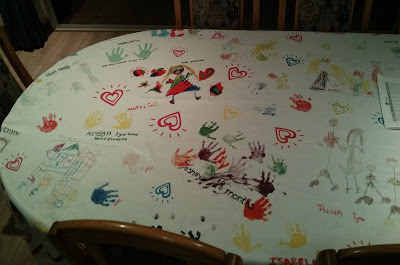
May this be a year of health, happiness, and success, and may we be inscribed in the Book of Life.
In July, on my trip to Africa, I spent a few days in Johannesburg before meeting my group. On my first evening, I was invited to dinner at the beautiful home of Jake and Loren Shepherd, readers of my work that have since become good friends. The table was loaded with food - biltong and other such African fare - but I was able to see part of the tablecloth, and it was not the type of fabric that I expected to see. The tablecloth contrasted sharply with the elegant decor of the rest of the house, in that it had children's handprints on it, in brightly colored paint.
"That's cute," I said to my hosts. "I assume that these are the handprints of your children?"
"Well, sort of," they replied, and explained in more detail.
In South Africa, Jewish couples with fertility problems face an added challenge: the high cost of IVF and other fertility treatments. Whereas the evil Zionist Torah-hating Amalekite government of Israel subsidizes such treatments, no such government aid is granted in South Africa. My hosts were deeply involved with a foundation called The Malka Ella Fertility Fund, which provides assistance to such couples in need.
As a result of the fund, many children came into existence. A souvenir tablecloth was made, in which all these children contributed artistically, with a picture or a handprint, depending on their age. I thought that it was the most beautiful tablecloth that I had ever seen - a celebration of life itself.

May this be a year of health, happiness, and success, and may we be inscribed in the Book of Life.
Published on September 03, 2013 11:14
September 1, 2013
Rav Elya Ber Dismisses Geonim, Rishonim, Acharonim, Gedolim
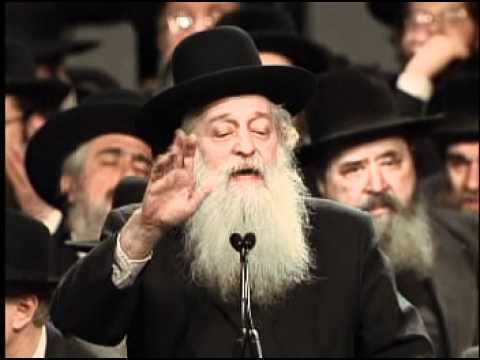 It's almost exactly nine years since a group of zealots, now out of commission, arranged for the charedi Gedolim to issue a controversial ban on three of my books and on the rationalist approach in general. Rav Elya Ber Wachtfogel, rosh yeshivah of South Fallsberg and one of the prime forces behind the ban, is now once again on a tirade against rationalist Judaism.
It's almost exactly nine years since a group of zealots, now out of commission, arranged for the charedi Gedolim to issue a controversial ban on three of my books and on the rationalist approach in general. Rav Elya Ber Wachtfogel, rosh yeshivah of South Fallsberg and one of the prime forces behind the ban, is now once again on a tirade against rationalist Judaism.His platform this time is an approbation to a small book published by a disciple of his entitled Sod Liyreyav, which deals with the subjection of spontaneous generation and related topics regarding Chazal's statements about the natural world. Rav Elya Ber's approbation is unusually long, stretching nearly three pages. He emphatically states that everything in the Gemara, as well as in the writings of the Rishonim, is factually true in its plain meaning. Rav Elya Ber claims that every single utterance of Chazal was stated by Sinaitic transmission and/or by way of sod Hashem liyreyav (even though if one actually researches the usages of that phrase, one sees very clearly that Chazal believed it to have extremely limited application). Astonishingly, in making this fantastic claim, he refers to Rambam's introduction to the Mishnah; he does not give a specific reference, presumably because Rambam said no such thing and in fact clearly held strongly otherwise. And Rav Elya Ber further claims that science has never attained the slightest insight into the universe compared to the insights that have been obtained from the Torah (alas giving no examples to support this extraordinary claim).
As far as I am concerned, if Rav Elya Ber wants to believe in the existence of mice that grow from dirt and salamanders that grow from fire, along with humanoids that grow from the ground and werewolves, that is his prerogative, and it doesn't bother me. Likewise, if he wants to take a different position than the view of countless Rishonim, Acharonim, and Gedolim (not to mention Chazal themselves), that is fine.
But this is not merely a matter of his personal view. Rav Elya Ber emphatically insists that any other approach is false, evil, and is kefirah, heresy. He further states that his approach is the explicit, well-known and obvious approach throughout the generations. And he adds that alternate views are only presented from sources of dubious authenticity, personal communications to people questioning inappropriately, or long-rejected aberrant views.
When my books were banned, I was under the mistaken impression that to say that Chazal were sometimes mistaken in their statements about the natural world was the legitimate minority view of Rambam, his son Rabbeinu Avraham, and Rav Hirsch. I was wrong on two counts. One is that it is clearly not legitimate in certain sectors, notwithstanding its pedigree. My other mistake was to think that it was a rare minority view. In the nine years that have elapsed since the ban, with many people researching the topic, I have discovered that this view was absolutely mainstream amongst the Rishonim and also had considerable support amongst the Acharonim. I further discovered that every single Gaon and Rishon, bar none, learned Pesachim 94b in accordance with its straightforward meaning, as saying that Chazal believed that the sun doubles back and passes behind the sky at night. Most also held that Chazal were mistaken in this belief.
Rav Elya Ber is entitled to dispute the position of R. Sherira Gaon, R. Hai Gaon, Rambam, R. Eliezer of Metz, Tosafos Rid, R. Avraham ben HaRambam, Semag, Rosh, Ritva, R. Bachya b. Asher, R. Yerucham ben Meshullam, Rabbeinu Manoach, R. Eliyahu Mizrachi, R. Yitzchak Arama, Maharam Alashkar, Radbaz, R. Yosef Shlomo Delmedigo, R. Moshe Cordovero, Lechem Mishneh, Maharsha, Minchas Kohen, Chavos Ya’ir, Pri Chadash, Maharif, R. Yitzchak Lampronti, Maharam Schick, R. Binyamin Musafia, R. Eliezer Lipman Neusatz, R. Dovid Friedman (Karliner), R. Samson Raphael Hirsch, R. Moshe Shmuel Glasner, Ben Ish Chai, R. Herzog, R. Dessler, R. Carmell, and, yibadlu lechaim, R. Shlomo Fisher and R. Ephraim Greenblatt, amongst many others. But to condemn their view as false, evil, and heresy, however, seems out of place - to put it mildly. And to dismiss this approach as never having had a legitimate place in Judaism is an outright perversion of the history of Torah scholarship.
Unfortunately, while many people agree with me - even in the charedi world - nobody has the courage to actually call out Rav Elya Ber on this offensive approach to Geonim, Rishonim, Acharonim and Gedolim. Perhaps someone can ask him to methodically address, for example, all the sources regarding the sun's path at night. In the meanwhile, Rav Elya Ber has transmitted a clear message about charedi Gedolim and Torah scholarship.
Published on September 01, 2013 07:12
August 28, 2013
Wrestling With Burqa Babes
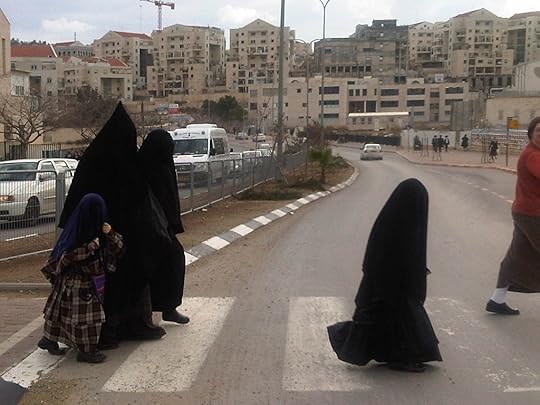 Mishpacha magazine's lead story this week wrestles with the topic of the women commonly known as "burqa ladies" or "burqa babes" - the increasing number of Orthodox Jewish women who wear burqas (and sometimes even gloves). The article presents interviews with several such women. It's fascinating to read about how these people think.
Mishpacha magazine's lead story this week wrestles with the topic of the women commonly known as "burqa ladies" or "burqa babes" - the increasing number of Orthodox Jewish women who wear burqas (and sometimes even gloves). The article presents interviews with several such women. It's fascinating to read about how these people think.But the article is also fascinating for another reason. Usually, the charedi media reflects a very clear set of values. Torah = good. Evolution = bad. UTJ = good. Bayit Yehudi/ Yesh Atid = bad. Gadol = effectively infallible. And so on. But it's very hard to tell whether this article is siding with the Burqa ladies or with their critics - or perhaps with neither, which would be remarkable. The vast majority of the article is sympathetic to their approach, and so are all the pull quotes (the sentences that are printed in huge letters alongside the article). On the other hand, the very last column of the article is critical of them, stating that they are effectively drawing attention to themselves, and being ostentatious in their religious approach. I find it amazing that a charedi publication is so ambiguous about such an issue.
In an old post, Photoshopping Females and Knee-Jerk Reactions, I grappled with the question of how one can condemn "extreme" modesty measures while simultaneously maintaining a standard of modesty that would itself appear bizarre to most people in the countries where we live. I'm still very unsure about it, but I suggested that the problem is as follows: There are lots of things that can potentially lead to hirhurim - and yet Chazal did not prohibit them. This can lead to difficult judgments on a subjective case-by-case basis - but Chazal held that those judgments should indeed be made on a such a basis, rather than simply broadly prohibiting everything. Now, individuals, and even communities, can legitimately have pious practices which are not halachah-based. But the problem is not that such people are maintaining a certain standard. It is that they are not maintaining a certain standard! They have abandoned the standard of their parents, and they have replaced it with a process, and a problematic one at that. It is a process of ever-increasing stricture, with each new pious innovation starting as a personal preference, and developing into an obligatory halachah and imposed upon others. The article quotes a burqa lady as saying that "desperate times call for desperate measures," and giving the message that the ultimate ideal is for a woman to never leave the house at all.
Also of interest is that the Mishpacha article does not show any pictures of these women, instead showing numerous pictures of a doll draped in a burqa. Somebody sent me a letter that they wrote to Mishpacha regarding this:
Dear Editor,As I wrote in my original blog post, in a society in which it is forbidden to show pictures of women, it is hardly surprising that women start to wear burqas. And if it's forbidden to show pictures of women even if they wear burquas, then the natural end result is that women will eventually see it as an ideal (and then an imposed standard) not to leave the house at all.
Thank you for reporting about women who misguidedly wear burka-type garments to cover over their form. They mistakenly believe that they can only be seen by others if they are totally covered. However it is interesting that Mishpocha Magazine goes further and feels that even fully covered they cannot be seen and hence no pictures of them in the article about them.
Sincerely,
Noson Yanofsky
I will sign off with two ads for the maternity ward of Laniado hospital that appeared in the same week - one in Makor Rishon, and one in Mishpacha. See if you can spot the difference. (Thanks to reader Avraham Poupko's daughter Roni for noticing it.)
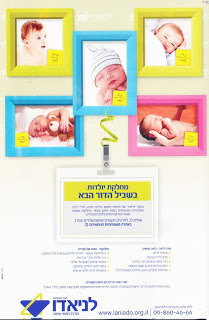

Published on August 28, 2013 08:24
August 21, 2013
Anne Samson – “Ema”
(Thanks to all those who wrote in with messages of support, as well as to those who wanted to but refrained out of sensitivity to my email overload. I was not able to reply to each message, nor to process comments for the previous post, but everything was read and appreciated.)
Following is the text of the eulogy that I delivered in Israel. Shiva details appear in the previous post.
For those who don’t know her background, Anne Samson was born Anne Katz in a Displaced Person’s camp in Austria. As a small child, she moved to Los Angeles. Fifty years ago, when s
he was sixteen years of age, she and Lee Samson met in Bnei Akiva and became high school sweethearts. They were married three years later. After spending some time volunteering on a kibbutz, they settled back in Los Angeles. They became pillars of the community, involved in a wide range of projects and institutions in Israel as well as Los Angeles.
When I joined the Samson family, thirteen years ago, I was very nervous about meeting my mother-in-law to be. You hear a lot of jokes about mothers-in-law being dominating, interfering, and difficult. But I never got to understand what those jokes are about. Anne Samson – or Ema, as I called her – was never anything other than kind, loving, supportive and helpful. In thirteen years, the only time she was ever forceful with me was when I was once suffering from severe stomach pains. I had refused to go to a doctor, due to my having forgotten to take out travel insurance, and being convinced that it was nothing serious. Ema made an appointment for me with a specialist without my knowledge, and then talked me into going, whereupon the doctor rushed me to hospital to remove my ruptured appendix.
My wife, Tali, asked me to stress how Ema was the most selfless, generous, giving, helpful, kind person – there simply aren’t adequate words to praise her. She never said “no.” She was always smiling and full of warmth. Although she was blessed with a luxurious lifestyle, she was completely down-to-earth, with genuine modesty and no airs and graces.
Ema epitomized the mitzvah of hachnassas orchim. She constantly hosted large groups, for which she would cook up a storm. Her Shabbos meals would be like Yom Tov feasts, and her Yom Tov meals like banquets. Hashem granted her one last chance to fulfill the mitzvah of hachnassas orchim on the day of the tragic accident. A friend of Tali and Aliza was having a stressful visit to LA to help her elderly mother emigrate. Tali had invited her to come over and relax with her in her parents’ pool. On Thursday, when she was available to come, Tali was not in the house. Nonetheless, Ema told her that she should come anyway. Not only did she welcome this stranger to her home, but according to our friend, Ema was the most gracious and friendly hostess, and this woman felt an instant warmth and connection. Tali’s last conversation with her mother was when she called her that day. After a short while she said “I'm sorry Tali, I have to go, I was just with my guest and I don't want to keep her waiting.” This was who she was: a warm, caring, happy and giving person, who opened her home and her heart whenever she was given the opportunity.
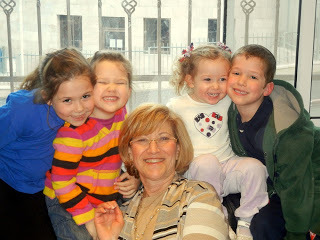 In Ema’s final days in this world, she went out with her husband to a restaurant for a romantic dinner, she sat on the beach with my children and helped them build sandcastles, and she visited the new camp Moshava Malibu. This perfectly encapsulates the three major elements of her life – her loving relationship with her husband, her devotion to her family, and her involvement with the community and Eretz Yisrael.
In Ema’s final days in this world, she went out with her husband to a restaurant for a romantic dinner, she sat on the beach with my children and helped them build sandcastles, and she visited the new camp Moshava Malibu. This perfectly encapsulates the three major elements of her life – her loving relationship with her husband, her devotion to her family, and her involvement with the community and Eretz Yisrael. Ema, we are going to miss you so much. We will especially miss your phone calls and Skype conversations, celebrating chagim and family events, spending summers together. We will miss your smile and contagious laughter, and we will miss seeing your happiness when you talk and play with your grandchildren. We love you and we will always remember you.
Published on August 21, 2013 20:53
August 17, 2013
Baruch Dayan Ha-Emet (updated with shiva times)
With great sadness, I am reporting the tragic passing of my beloved mother-in-law, Mrs. Anne Samson, who was killed in a car accident on Friday. My father-in-law was released from hospital on Sunday.
The levaya is planned for 3:30pm today (Tuesday) at Eretz HaChayim on route 38. The plane is expected to arrive on time. (Although a large number of people are expected to come, I am not sure that it makes sense to arrive too early, because there is another funeral immediately beforehand.)
My wife and sister are sitting shiva in Israel at the Rosenstein's, Nachal Refaim 7/2, until Monday morning; my father-in-law, who is not yet able to travel, is sitting shivah in LA.
Shiva times in Ramat Bet Shemesh are as follows:
Wednesday: Shacharis 7:30am. Shiva times: After shachris, 11am - 2pm, 6:30pm - 9:30pm. Mincha/Maariv - 7:05pm
Thursday: 11am - 2pm, 6:30pm - 9:30pm
Friday: 10am - 2pm
Motzei Shabbos: 9pm - 10pm
Sunday: 11am - 2pm, 6:30pm - 9:30pm
Please respect the times above. If you are traveling from afar, please call 052-662-3256 if you arrive at an off-time to confirm their availability.
The levaya is planned for 3:30pm today (Tuesday) at Eretz HaChayim on route 38. The plane is expected to arrive on time. (Although a large number of people are expected to come, I am not sure that it makes sense to arrive too early, because there is another funeral immediately beforehand.)
My wife and sister are sitting shiva in Israel at the Rosenstein's, Nachal Refaim 7/2, until Monday morning; my father-in-law, who is not yet able to travel, is sitting shivah in LA.
Shiva times in Ramat Bet Shemesh are as follows:
Wednesday: Shacharis 7:30am. Shiva times: After shachris, 11am - 2pm, 6:30pm - 9:30pm. Mincha/Maariv - 7:05pm
Thursday: 11am - 2pm, 6:30pm - 9:30pm
Friday: 10am - 2pm
Motzei Shabbos: 9pm - 10pm
Sunday: 11am - 2pm, 6:30pm - 9:30pm
Please respect the times above. If you are traveling from afar, please call 052-662-3256 if you arrive at an off-time to confirm their availability.
Published on August 17, 2013 22:05
Baruch Dayan Ha-Emet (updated)
With great sadness, I am reporting the tragic passing of my beloved mother-in-law, Mrs. Anne Samson, who was killed in a car accident on Friday. My father-in-law was released from hospital yesterday. The funeral will take place in Israel on Tuesday and shivah will take place in Ramat Bet Shemesh and in Los Angeles.
(Your good wishes are appreciated, but if possible, please refrain from submitting comments or sending emails at this time.)
(Your good wishes are appreciated, but if possible, please refrain from submitting comments or sending emails at this time.)
Published on August 17, 2013 22:05

